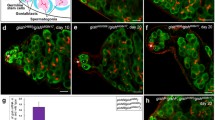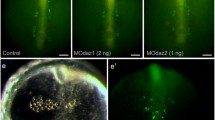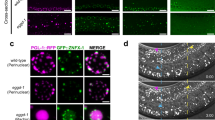Abstract
Xenopus dazl encoding an RNA-binding protein has been identified as a component of the germ plasm and is involved in the migration and differentiation of the primordial germ cells (PGCs). Here, we investigated the intracellular localization of Dazl in germline cells throughout the lifetime of Xenopus. In early embryogenesis, Dazl was detected initially in the germ plasm and then translocated to a perinuclear region. Then, it was detected within the nucleus in PGCs. Dazl was observed only in the cytoplasm in PGCs when sex differentiation began in the gonads. Dazl was distributed in both the nucleus and cytoplasm of the primary oogonium and spermatogonium, but only in the cytoplasm of the secondary oogonium and spermatogonium. In spermatocytes, Dazl was distributed throughout cytoplasm and localized at the spindles and cytoplasm during meiosis. Then, it was detected as speckles in the nucleus in the round spermatid. The dynamic intracellular localization suggests that Dazl is a multifunctional protein regulating RNA metabolism required for Xenopus germline development.






Similar content being viewed by others
References
Berekelya LA, Mikryukov AA, Luchinskaya NN, Ponomarev MB, Woodland HR, Belyavsky AV (2007) The protein encoded by the germ plasm RNA Germes associates with dynein light chains and functions in Xenopus germline development. Differentiation 75:546–558
Chen J, Melton C, Suh N, Oh JS, Horner K, Xie F, Sette C, Blelloch R, Conti M (2011) Genome-wide analysis of translation reveals a critical role for deleted in azoospermia-like (Dazl) at the oocytes-to zygote transition. Gene Dev 25:755–766
Cheng MH, Maines JZ, Wasserman SA (1998) Biphasic subcellular localization of the DAZL-related protein boule in Drosophila spermatogenesis. Dev Biol 204:567–576
Collier B, Gorgoni B, Loveridge C, Cooke HJ, Gray NK (2005) The DAZL family proteins are PABP-binding proteins that regulate translation in germ cells. EMBO J 24:2656–2666
Eberhart CG, Maines JZ, Wasserman SA (1996) Meiotic cell cycle requirement for a fly homologue of human deleted in Azoospermia. Nature 381:783–785
Eliscovich C, Peset I, Vernos I, Méndez R (2008) Spindle-localized CPE-mediated translation controls meiotic chromosome segregation. Nat Cell Biol 10:858–865
Gill ME, Hu Y-C, Lin Y, Page DC (2011) Licensing of gametogenesis, dependent on RNA binding protein DAZL, as a gateway to sexual differentiation of fetal germ cells. Proc Natl Acad Sci USA 108:7443–7448
Hasegawa E, Karashima T, Sumiyoshi E, Yamamoto M (2006) C. elegans CPB-3 interacts with DAZ-1 and functions in multiple steps of germline development. Dev Biol 295:689–699
He J, Stewart K, Kinnell HL, Anderson RA, Childs AJ (2013) A developmental stage-specific switch from DAZL to BOLL occurs during fetal oogenesis in human, but not mice. Plos One 8:e73996
Houston DW, King ML (2000) A critical role for Xdazl, a germ plasm-localized RNA, in the differentiation of primordial germ cells in Xenopus. Development 127:447–456
Houston DW, Zhang J, Maines JZ, Wasserman SA, King ML (1998) A Xenopus DAZ-like gene encodes an RNA component of germ plasm and is a functional homologue of Drosophila boule. Development 125:171–180
Karashima T, Sugimoto A, Yamamoto M (2000) Caenorhabditis elegans homologue of the human azoospermia factor DAZ is required for oogenesis but not for spermatogenesis. Development 127:1069–1079
Kataoka K, Yamaguchi T, Orii H, Tazaki A, Watanabe K, Mochii M (2006) Visualization of the Xenopus primordial germ cells using a green fluorescent protein controlled by cis elements of the 3’ untranslated region of DEADSouth gene. Mech Dev 123:746–760
Kee K, Angeles VT, Flores M, Nguyen HN, Reijo Pera RA (2009) Human DAZL, DAZ and BOULE genes modulate primordial germ-cell and haploid gamete formation. Nature 462:222–225
Kim B, Cooke HJ, Rhee K (2012) DAZL is essential for stress granule formation implicated in germ cell survival upon heat stress. Development 139:568–578
Kronja I, Orr-Weaver TL (2011) Translational regulation of the cell cycle: when, where, how and why? Philos Trans R Soc B 366:3638–3652
Kurihara Y, Watanabe H, Kawaguchi A, Hori T, Mishiro K, Ono M, Sawada H, Uesugi S (2004) Dynamic changes in intracellular localizations of mouse Prrp/DAZAP1 during spermatogenesis: the necessity of the C-terminal proline-rich region for nuclear import and localization. Arch Histol Cytol 67:325–333
Lee KH, Lee S, Kim B, Chang S, Kim SW, Paick J-S, Rhee K (2006) Dazl can bind to dynein motor complex and may play a role in transport of specific mRNAs. EMBO J 25:4263–4270
Lin YM, Chen CW, Sun HS, Tsai SJ, Hsu CC, Teng YN, Lin JSN, Kuo PL (2001) Expression patterns and transcript concentrations of the autosomal DAZL gene in testes of azoospermic men. Mol Hum Reprod 7:1015–1022
MacArthur H, Houston DW, Bubunenko M, Mosquera L, King ML (2000) DEADSouth is a germ plasm specific DEAD-box RNA helicase in Xenopus related to eIF4A. Mech Dev 95:291–295
Machado RJ, Moore W, Hames R, Houliston E, Chang P, King ML, Woodland HR (2005) Xenopus Xpat protein is a major component of germ plasm and may function in its organisation and positioning. Dev Biol 287:289–300
Mita K, Yamashita M (2000) Expression of Xenopus Daz-like protein during gametogenesis and embryogenesis. Mech Dev 94:251–255
Nieuwkoop PD, Faber J (1994) Normal table of Xenopus laevis (Daudin): a systematical and chronological survey of the development from the fertilized egg till the end of metamorphosis. Garland Publication, New York
Orii H, Sakurai T, Watanabe K (2005) Distribution of the stem cells (neoblasts) in the planarian Dugesia japonica. Dev Genes Evol 215:143–157
Reijo RA, Dorfman DM, Slee R, Renshaw AA, Loughlin KR, Cooke H, Page DC (2000) DAZ family proteins exist through male germ cell development and transit from nucleus to cytoplasm at meiosis in humans and mice. Biol Reprod 63:1490–1496
Reynolds N, Collier B, Maratou K, Bingham V, Speed RM, Taggart M, Semple CA, Gray NK, Cooke HJ (2005) Dazl binds in vivo to specific transcripts and can regulate the pre-meiotic translation of Mvh in germ cells. Hum Mol Genet 14:3899–3909
Ruggiu M, Speed R, Taggart M, McKay SJ, Kilanowski F, Saunders P, Dorin J, Cooke HJ (1997) The mouse Dazla gene encodes a cytoplasmic protein essential for gametogenesis. Nature 389:73–77
Saunders PTK, Turner JMA, Riggiu M, Taggart M, Burgoyne PS, Elliott D, Cooke HJ (2003) Absence of mDazl produces a final block on germ cell development at meiosis. Reproduction 126:589–597
Tada H, Orii H, Mochii M, Watanabe K (2012) Ectopic formation of primordial germ cells by transplantation of the germ plasm: direct evidence for germ cell determinant in Xenopus. Dev Biol 371:86–93
Taguchi A, Takii M, Motoishi M, Orii H, Mochii M, Watanabe K (2012) Analysis of localization and reorganization of germ plasm in Xenopus transgenic line with fluorescence-labeled mitochondoria. Dev Growth Differ 54:767–776
Taguchi A, Watanabe K, Orii H (2015) Intracellular localizations of the dead end protein in Xenopus primordial germ cells. Int J Dev Biol 59 (In press)
Takeda Y, Mishima Y, Fujiwara T, Sakamoto H, Inoue K (2009) DAZL relieves miRNA-mediated repression of germline mRNAs by controlling poly(A) tail length in zebrafish. Plos One 4:e7513
VanGompel MJW, Xu EY (2010) A novel requirement in mammalian spermatid differentiation for the DAZ-family protein Boule. Hum Mol Genet 19:2360–2369
VanGompel MJW, Xu EY (2011) The roles of the DAZ family in spermatogenesis. Spermatogenesis 1:36–44
Venkatarama T, Lai F, Luo X, Zhou Y, Newman K, King ML (2010) Repression of zygotic gene expression in the Xenopus germline. Development 137:651–660
Vera Y, Dai T, Hikim APS, Lue Y, Salido EC, Swerdloff RS, Yen PH (2002) Deleted in azoospermia associated protein 1 shuttles between nucleus and cytoplasm during normal germ cell maturation. J Androl 23:622–628
Villalpando I, Merchant-Larios H (1990) Determination of the sensitive stages for gonadal sex-reversal in Xenopus laevis tadpoles. Int J Dev Biol 34:281–285
Xu EY, Moore FL, Reijo Pera RA (2001) A gene family required for human germ cell development evolved from ancient meiotic gene conserved in metazoans. Proc Natl Acad Sci USA 98:7414–7419
Yamaguchi T, Taguchi A, Watanabe K, Orii H (2013) DEADSouth protein localizes to germ plasm and is required for the development of primordial germ cells in Xenopus laevis. Biol Open 2:191–199
Yu Z, Ji P, Cao J, Zhu S, Li Y, Zheng L, Chen X, Feng L (2009) Dazl promotes germ cell differentiation from embryonic stem cells. J Mol Cell Biol 1:93–103
Acknowledgments
We are grateful to Koichi Mita (Tokushima Bunri Univ.) and Masakane Yamashita (Hokkaido Univ.) for the anti-Xdazl monoclonal antibody (referred to as anti-Dazl in this study), and Hideo Nishitani and Fumiko Hirose (Univ. Hyogo) for the anti-tubulin antibody. We thank Shin-ichiro Nishitani (Minoo-Higashi high school) for staging meiosis, and Kensuke Kataoka, Midori Kitao and Kenji Watanabe (Univ. Hyogo) for sharing their preliminary data. We also thank members of our laboratory, especially Makoto Mochii and Yoshihiko Umesono, for their support and encouragement. This study was supported in part by Japan Society for the Promotion of Science KAKENHI (Grant Number 257228) to HT.
Author information
Authors and Affiliations
Corresponding author
Rights and permissions
About this article
Cite this article
Tada, H., Orii, H. Dynamic intracellular localization of Dazl protein during Xenopus germline development. Histochem Cell Biol 144, 157–166 (2015). https://doi.org/10.1007/s00418-015-1323-5
Accepted:
Published:
Issue Date:
DOI: https://doi.org/10.1007/s00418-015-1323-5




